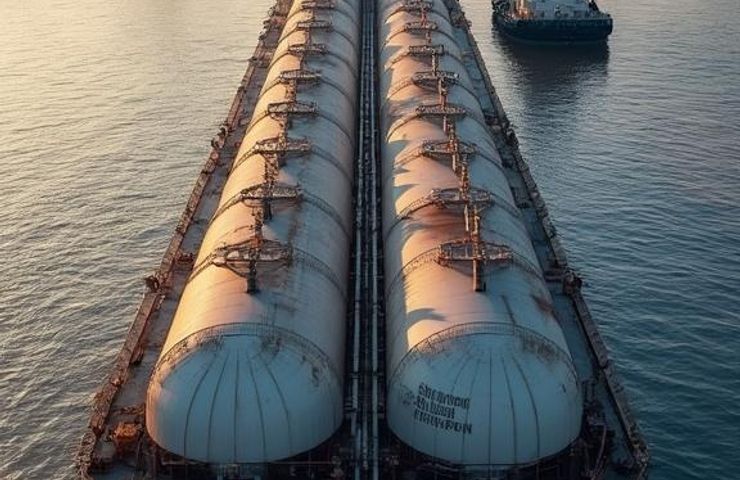
Hydrogen Infrastructure: Port of South Louisiana Tenders First E-Methanol Fueling Barge
August 25, 2025Picture a floating fueling station—no docks or concrete pads, just a sleek steel barge bobbing along the Mississippi. That’s exactly what Port of South Louisiana has in the works: a cutting-edge hydrogen fueling barge ready to pump e-methanol and other green fuels straight into ships, totally changing the game for marine refueling.
Project Overview and Scope
The port has put out a call for bids on a custom-built vessel designed to carry Grade C flammable liquids. At its heart is e-methanol—a synthetic marine fuel crafted by combining green hydrogen from renewable electrolysis with captured CO₂. In plain terms, this barge turns the river into a refueling superhighway. It’s powered by a Build Back Better Regional Challenge grant from the U.S. Economic Development Administration, matched by funding and technical support from Louisiana Economic Development. As part of the H2theFuture initiative, the barge complements an array of projects—electrolyzers, hydrogen pipelines, workforce training programs—all aimed at accelerating industrial decarbonization in South Louisiana.
- Comprehensive engineering and fabrication plans covering steel sourcing, internal coatings, and system integration.
- Performance guarantees for transfer rates and leak-prevention systems.
- Optional add-ons: long-term maintenance, crew training, and remote monitoring services.
- Proven safety expertise with hydrogen-based fuels and marine fueling systems.
Technical Design Highlights
This non-self-propelled, double-hulled steel barge packs:
- Five pairs of insulated cargo tanks with corrosion-resistant linings, perfect for storing e-methanol.
- A pump house capable of 6,000 barrels per hour loading and 1,000 gallons per minute offloading.
- Advanced safety gear: automatic leak detectors, remote shutoff valves, foam suppression, and secondary containment.
- Interchangeable hose connections compatible with existing shore-side bunker equipment.
- Future-ready pipework prepped for pure hydrogen transfer, making upgrades seamless as markets evolve.
Designed to meet or exceed U.S. Coast Guard and EPA regulations, the barge features a SCADA system for real-time operations oversight—fueling everything from tugboats to small ferries.
Strategic and Business Benefits
Why float your fueling station? First off, vessels save hours by skipping back-and-forth trips, cutting congestion at busy docks and slashing operating costs. For the port, it unlocks new revenue streams—fuel sales margins, handling fees, service contracts, you name it. With hydrogen infrastructure investment on the rise, South Louisiana scores a first-mover advantage. Early entry into the green hydrogen bunkering market positions the port as a hub for zero-emission tech, attracting operators eager to meet stricter emissions standards. Plus, it boosts the port’s ESG profile, potentially lowering the cost of capital as financiers reward real decarbonization efforts.
Advancing Industrial Decarbonization
The Mississippi corridor already handles massive volumes of industrial hydrogen used in refining and chemical processes. Switching marine bunkering from diesel to e-methanol can cut lifecycle greenhouse gas emissions by up to 100%, provided renewable feedstocks are used. That shift not only helps Louisiana hit its net-zero-by-2050 targets but also reduces nitrogen oxide and particulate emissions that affect nearby communities. Every barge call using e-methanol instead of diesel prevents tons of local pollutants while supporting corporate sustainability goals.
Regional Legacy and Context
South Louisiana’s energy story stretches back over a century, evolving from crude oil exports to a sprawling petrochemical powerhouse. The Port of South Louisiana ranks among the Western Hemisphere’s largest tonnage ports, moving grains, bulk commodities, and hydrocarbons. Beneath the surface, a dense network of hydrogen pipelines, storage terminals, and electrolyzers already feeds refineries and chemical plants. In 2022, this corridor was one of six U.S. regions tapped by the Build Back Better Regional Challenge for clean hydrogen cluster funding. The floating fueling barge is the latest chapter in a region rewriting its energy narrative for the sustainable energy era.
Funding, Partnerships, and Governance
The project’s total budget is $74.5 million, pooled from:
- U.S. Economic Development Administration: Core grant funding under the Build Back Better Challenge.
- Louisiana Economic Development: State matching funds, permitting support, and workforce development programs.
- H2theFuture: A 25-member coalition guiding project alignment, technical reviews, and training pipelines.
This alliance of federal, state, and private stakeholders shows how targeted policy incentives can unlock advanced clean-energy infrastructure.
Timeline and Critical Milestones
- Bid submission deadline: August 28, 2025
- Contract award: by September 24, 2025
- Engineering & procurement: Q4 2025 – Q2 2026
- Fabrication & system integration: Q3 2026 – Q4 2026
- Sea trials & commissioning: Q1 2027
- Operational launch: March 31, 2027
When it hits the water, this barge will be the first of its kind in the United States, cementing South Louisiana’s leadership in hydrogen production and distribution.
Risks, Challenges, and What to Watch
Ambitious projects come with their share of hurdles:
- Supply chain pressures on specialized hoses, valves, and steel alloys could stretch fabrication schedules.
- Regulatory evolution: As state and federal agencies fine-tune hydrogen bunkering guidelines, designs may need adjustments.
- Feedstock economics: The price edge of e-methanol hinges on renewable power costs and CO₂ sourcing.
- Workforce readiness: Fabricators, welders, and operators require training on new materials and safety procedures.
Stakeholders should keep an eye on vendor proposals, permit updates, and market shifts in renewable power and CO₂ pricing.
Looking Ahead and Broader Implications
The Port of South Louisiana’s floating fueling station could serve as a lighthouse for maritime decarbonization. If this model proves workable, expect other inland and coastal ports to explore similar hydrogen infrastructure projects. Down the road, we might see retrofitted barges dispensing green ammonia or even pumping pure hydrogen into fuel cell–powered vessels. For now, all eyes are on the bids, the build, and that game-changing launch.



 With over 15 years of reporting hydrogen news, we are your premier source for the latest updates and insights in hydrogen and renewable energy.
With over 15 years of reporting hydrogen news, we are your premier source for the latest updates and insights in hydrogen and renewable energy.